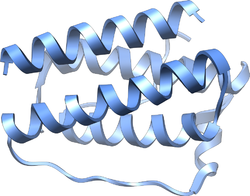- Leptin
-
Leptin Leptin nach PDB 1ax8 Vorhandene Strukturdaten: PDB 1ax8 Masse/Länge Primärstruktur 167 aa; 18,64 kD Bezeichner Gen-Namen LEP; OB; OBS Externe IDs OMIM: 164160 MGI: 104663 Vorkommen Übergeordnetes Taxon Euteleostomi Orthologe Mensch Maus Entrez 3952 16846 Ensembl ENSG00000174697 ENSMUSG00000059201 UniProt P41159 Q544U0 Refseq (mRNA) NM_000230 NM_008493 Refseq (Protein) NP_000221 NP_032519 Genlocus Chr 7: 127.67 - 127.68 Mb Chr 6: 29.01 - 29.02 Mb PubMed Suche [1] [2] Leptin (griech.: λεπτός leptos = „dünn“) ist ein Proteohormon, das 1994 durch den Molekularbiologen Jeffrey Friedman entdeckt wurde.[1] Leptin wird durch das „obese“-Gen kodiert und hauptsächlich von Fettzellen (Adipozyten) abgegeben, in geringen Mengen aber auch in der Plazenta, der Magenschleimhaut, dem Knochenmark, dem Brustepithel, dem Skelettmuskel, der Hirnanhangsdrüse und dem Hypothalamus.[2][3][4] Leptin hemmt das Auftreten von Hungergefühlen und spielt eine wichtige Rolle bei der Regulierung des Fettstoffwechsels von Menschen und anderen Säugern.
Rezeptoren für Leptin (Ob-Rs) konnten in zwei unterschiedlichen Populationen von Neuronen in Kerngebieten des Nucleus arcuatus und Nucleus paraventricularis des Hypothalamus identifiziert werden. Die erste Gruppe dieser Neuronen produziert die appetitstimulierenden Neuropeptide AgRP (agouti-related protein) und NPY (Neuropeptid Y), welche durch das Leptin unterdrückt werden. Die zweite Population produziert POMC (Proopiomelanocortin) und CART (Cocaine- and Amphetamine-Regulated Transcript), beides Transmitterstoffe, die appetitzügelnd wirken. Diese werden durch Leptin aktiviert. In dem Maße, wie die Fettdepots des Körpers reduziert werden, nimmt auch die Konzentration des Leptins im Blutkreislauf ab, was wiederum eine Zunahme des Appetits bewirkt.
Durch Stimulation des sympathischen Nervensystems bewirkt Leptin auch eine Erhöhung des Blutdrucks, der Herzfrequenz sowie der Thermogenese durch Entkopplung der Zellatmung von der ATP-Synthese.[5]
Hoffnungen, dass Leptin sich als wirkungsvolles appetitzügelndes Medikament erweisen könnte, haben sich zunächst zerschlagen, als man feststellte, dass die meisten fettleibigen Menschen hohe Spiegel dieses Hormons aufweisen. Diese häufig hungrigen Patienten weisen keinen Mangel an Leptin (Leptindefizienz) auf, sondern leiden vielmehr an einer sog. Leptinresistenz. In diesem Zustand unterbleibt die physiologische Wirkung des Leptins auf die Zielneuronen. Der zugrunde liegende Mechanismus ist noch nicht aufgeklärt. Neuere Forschungen zeigen eine modulierende Wirkung, bzw. eine Interaktion von Stickoxiden und Leptin auf.[6][7] Früheren Studien zufolge weisen allerdings Stickoxide alleine schon eine appetitzügelnde Wirkung auf.[8]. Diese appetitzügelnde Wirkung der Stickoxide ist durch weitere Untersuchungen untermauert, die den Stickoxiden eine durstvermindernde Wirkung zuweist.[9]
Wie eine neue Studie an Mäusen zeigt, könnte sich Leptin auch bei Menschen mit Typ-1-Diabetes als Alternative zu Insulin erweisen. Vorteil gegenüber Insulin ist: Leptin ist offenbar ein besserer Gegenspieler von Glukagon, senkt daher Blutzuckerspiegel präziser. Andere Nachteile der Insulintherapie entfallen möglicherweise. Klinische Studien sollen diese Hypothesen verifizieren.[10]
Quellen
- ↑ Zhang Y, Proenca R, Maffei M, Barone M, Leopold L, Friedman JM: Positional cloning of the mouse obese gene and its human homologue. Nature. 1994 Dec 1;372(6505):425-32. Erratum in: Nature 1995 Mar 30;374(6521):479. PMID 7984236
- ↑ Bado A et al.: The stomach is a source of leptin. Nature 1998; 394:790-793
- ↑ Masuzaki H et al.:Non adipose tissue production of leptin: leptin as a novel placenta derived hormone in humans. Nat Med 1997; 3:1029-1033
- ↑ Morash B et al.: Leptin gene expression in the brain and pituitary gland. Endocrinology 1999; 140: 5995-5998
- ↑ David Nelson, Michael Cox: Lehninger Principles of Biochemistry. 4. Edition. W.H. Freeman, New York 2005, ISBN 0-7167-4339-6
- ↑ Yang SJ, Denbow DM; "Interaction of leptin and nitric oxide on food intake in broilers and Leghorns", Physiol Behav. 2007 May 18. PMID 17631366
- ↑ Morley JE, Alshaher MM, Farr SA, Flood JF, Kumar VB; "Leptin and neuropeptide Y (NPY) modulate nitric oxide synthase: further evidence for a role of nitric oxide in feeding.", Peptides. 1999;20(5):595-600. PMID 10465511
- ↑ Choi YH, Furuse M, Okumura J, Denbow DM; "Nitric oxide controls feeding behavior in the chicken.", Brain Res. 1994 Aug 15;654(1):163-6. PMID 7982091
- ↑ Calapai G, Caputi AP; "Nitric oxide and drinking behaviour.", Regul Pept. 1996 Oct 8;66(1-2):117-21. PMID 8899905
- ↑ Wang MY, Chen L, Clark GO, et al.: Feature Article: Leptin therapy in insulin-deficient type I diabetes. In: Proc Natl Acad Sci U S A. März 2010. doi:10.1073/pnas.0909422107. PMID 20194735.
Siehe auch
- Thermogenin
- Ghrelin und Cortisol beeinflussen ebenfalls das Hungergefühl
Weblinks
Wikimedia Foundation.

